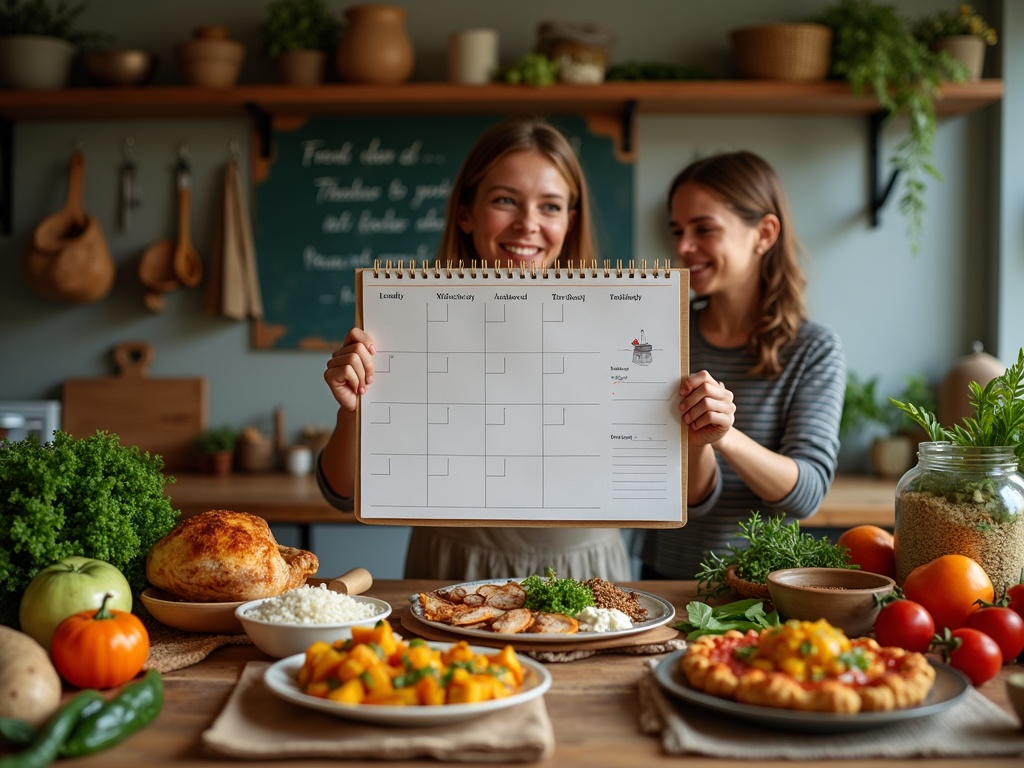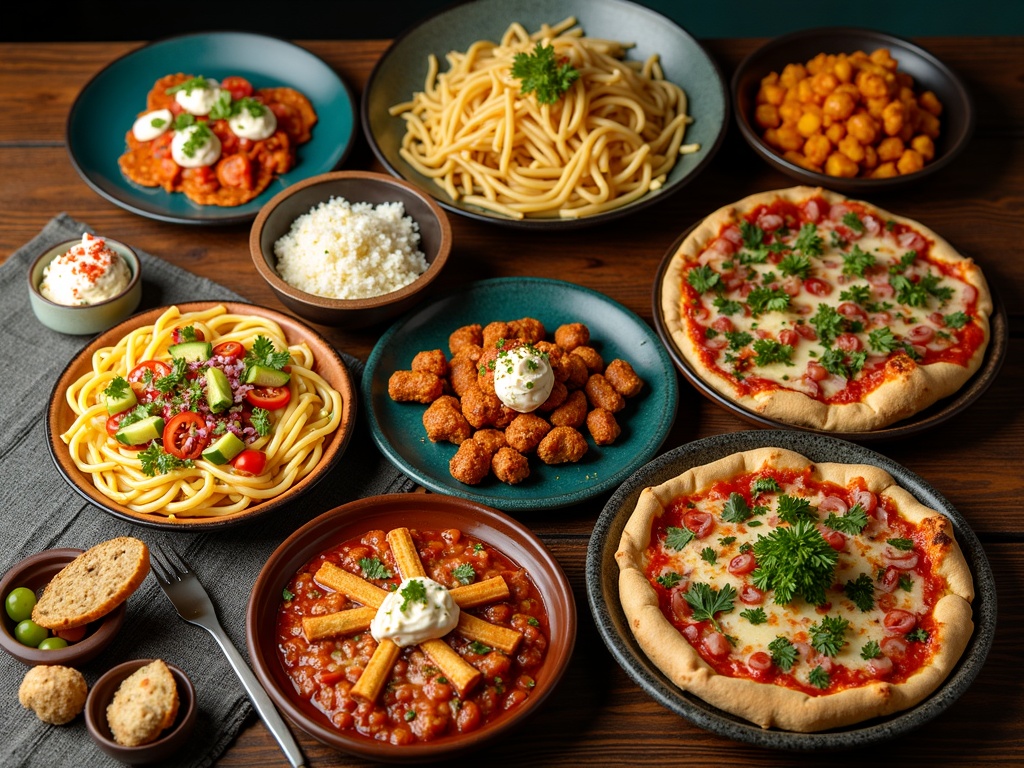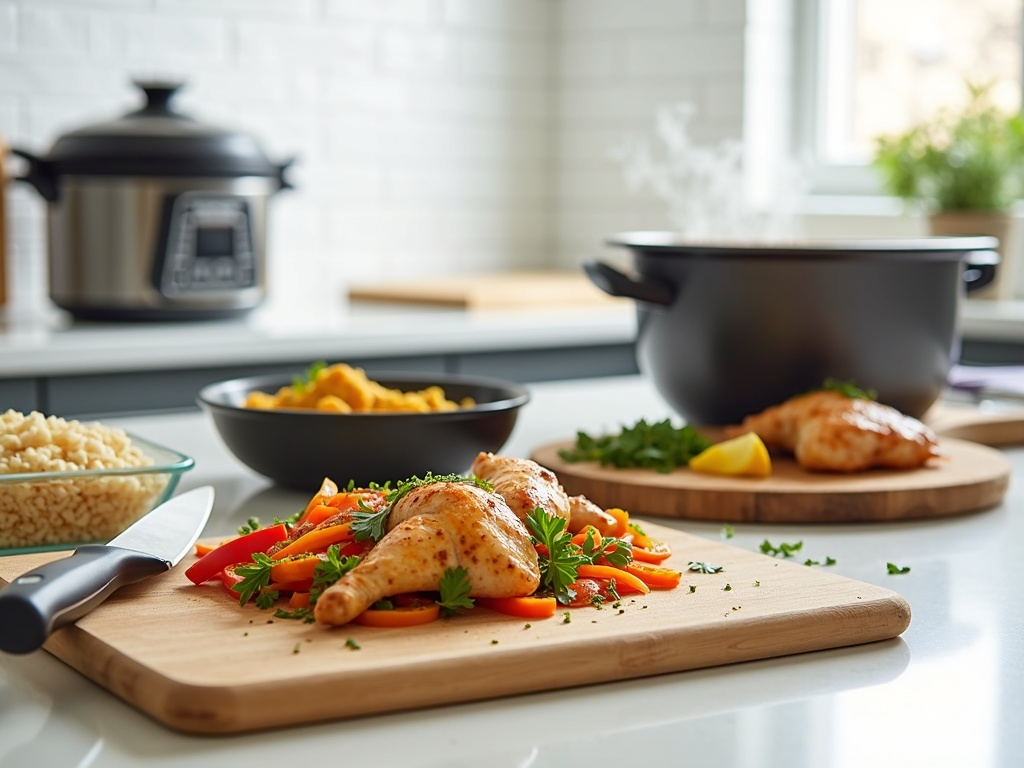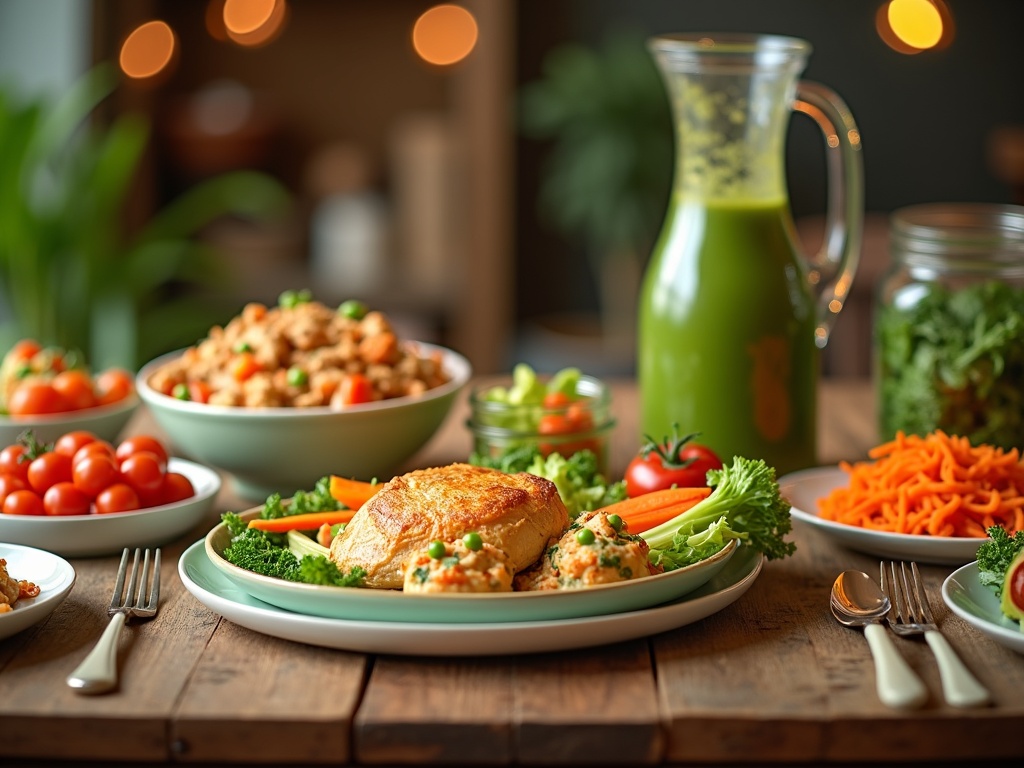Today Dinner planning reshapes both budget and nutrition, with home-cooked meals costing 60-75% less than restaurant equivalents while giving you full control over ingredients.
Global influences offer endless dinner inspiration, from Italian pasta dishes to Mexican tacos, while quick preparation techniques make healthy home cooking doable even for busy schedules.
Find In This Article
Key Takeaways
- Meal planning can reduce food expenses by 15-30%, with smart shopping and ingredient selection cutting the average annual dining-out spending of $4,643.
- One-pan meals and recipes with 10 or fewer ingredients cut weeknight cooking time, making home cooking practical even with packed schedules.
- Plant-based dinner options have gained significant popularity, now representing 20% of the global meal market in 2023.
- Intentionally preparing extra portions creates strategic leftovers that can be repurposed into different meals throughout the week.
- Most people consume only 1.6 servings of vegetables daily, well below the recommended 2.5-3 servings, but adding vegetables into favorite recipes can help bridge this nutritional gap.
Save Money While Eating Well
Did you know the average family spends a whopping $4,643 annually on dining out? That’s a significant chunk of change that could be better used elsewhere. I’ve found that cooking at home not only helps me control what goes into my meals but also dramatically cuts my food expenses. With rising food costs, I’ve developed strategies to eat well without breaking the bank.
Smart Planning for Maximum Savings
Meal planning is my secret weapon for reducing food costs. When I started planning my weekly meals, I cut my food expenses by nearly 25% – right in the middle of the typical 15-30% savings most families experience. I now spend Sunday afternoons mapping out dinners for the week, which helps me create a focused shopping list and avoid those expensive impulse purchases.
Some economical ingredients I always include in my meal plans:
- Beans and lentils (protein-packed and pennies per serving)
- Rice and other whole grains (versatile base for countless meals)
- Seasonal vegetables (always cheaper and more flavorful)
- Frozen vegetables (nutritionally comparable to fresh but with less waste)
- Whole chickens (much more economical than buying parts)
The cost differences between home cooking and takeout are striking. A homemade chicken pie recipe costs about $12-15 to feed a family of four, while ordering a similar meal from a restaurant would cost $40-50. Even seemingly inexpensive fast food adds up quickly – a family meal deal at $25 can be recreated at home with homemade burgers for less than $10.
I’ve transformed my shopping habits to maximize savings. Buying in bulk has become second nature for non-perishable items like rice, pasta, and canned goods. My local warehouse club membership pays for itself within months through savings on these staples. For fresh items, I shop at farmers’ markets late in the day when vendors often discount their produce rather than pack it up.
Another strategy is focusing on versatile ingredients that can star in multiple dishes. A whole chicken becomes tonight’s roast dinner, tomorrow’s chicken steak, and later powers a chicken lasagna. Even the bones make excellent broth for soups. This approach significantly reduces my cost per meal while keeping our menu exciting.
I’ve learned to embrace vegetarian meals several times weekly. A hearty vegetable curry costs a fraction of a meat-based dish while delivering outstanding flavor. Beans and lentils provide protein at a fraction of meat’s cost, and they’re incredibly filling in dishes like sausage casserole where a small amount of meat goes a long way.
Seasonal cooking has also transformed my budget. Shopping what’s in season means I’m buying at the point of highest supply and lowest prices. Summer tomatoes become pasta sauce to freeze for winter, and autumn apples turn into applesauce that lasts for months.
Food waste reduction plays a crucial role in my savings strategy. I designate one dinner each week as “clean out the fridge” night, where I get creative with whatever needs using up. This practice alone saves me about $20 weekly by preventing forgotten food from ending up in the trash.
By combining these approaches, I’ve cut my family’s food spending by over 40% while actually improving the quality of what we eat. The satisfaction of creating delicious, nutritious meals while watching my savings grow makes the small amount of planning totally worthwhile.

Popular Dinner Options Around the World
I’ve found that exploring dinner options from around the globe can transform an ordinary evening meal into something truly special. The diversity of flavors and cooking techniques offers endless possibilities for your dinner table.
Global Cuisine Favorites
Italian cuisine stands as one of the most beloved dinner choices worldwide. The versatility of pasta allows for countless variations – from creamy carbonara to spicy arrabiata. Pizza, with its perfect combination of crispy crust, tangy sauce, and melted cheese, has become a universal comfort food. The beauty of Italian cooking lies in its simplicity and focus on quality ingredients.
Mexican dishes bring bold flavors to dinner time. Tacos with their soft or crispy shells filled with seasoned meats, fresh vegetables, and zesty salsas create a customizable meal experience. Enchiladas, wrapped in corn tortillas and smothered in flavorful sauce, offer a heartier option that’s perfect for feeding a family. The combination of spices, chilies, and fresh ingredients makes Mexican cuisine both exciting and satisfying.
American classics have found their way onto dinner tables globally. Homemade burgers with juicy patties and creative toppings remain a favorite for casual dining. Fried chicken, with its crispy exterior and tender meat, represents comfort food at its finest. I’ve noticed these dishes work wonderfully for both weeknight meals and weekend gatherings.
Asian cuisine provides some of the most diverse dinner options. Sushi from Japan offers a light yet satisfying meal with its perfect balance of rice, seafood, and vegetables. Chinese stir-fry dishes deliver quick, nutritious meals packed with vegetables and proteins in flavorful sauces. The techniques and ingredient combinations from Asian cooking traditions have transformed how many people approach dinner preparation.
For something with a British influence, chicken pie recipes offer that perfect combination of flaky pastry and savory filling. The comforting appeal of a well-made pie makes it a dinner staple in many households.
Evolving Dinner Trends
The dinner landscape is changing rapidly with plant-based options gaining significant traction. According to market research, vegetarian and vegan meals now represent 20% of the global meal market in 2023. This shift has led to creative plant-based versions of classics like vegetable curry that deliver both nutrition and satisfaction.
The average dinner calorie range falls between 600-800 calories, striking a balance between satiation and nutritional needs. I’ve found this range allows for ample creativity while maintaining health-conscious choices. Dishes like chicken lasagna can be adjusted to fit within this calorie range while still delivering flavor and satisfaction.
Fusion dishes have gained popularity as people experiment with combining cooking techniques and flavors. Chicken steak prepared with Asian spices or Mexican-inspired sausage casserole show how traditional recipes are being reimagined for modern palates.
Dinner options today reflect our connected world, where culinary boundaries continue to blur. The wealth of recipes available means you can travel the globe from your dining table, experiencing authentic flavors and cooking methods from cultures far from your own. Whether you prefer the comfort of familiar classics or the adventure of trying new cuisines, dinner offers a daily opportunity to nourish both body and spirit.

Quick and Easy Meals for Busy Lives
Finding time to cook dinner can feel impossible with today’s hectic schedules. I understand the struggle – according to recent surveys, 75% of people want to cook more but simply lack the time. With the average dinner preparation taking between 30-45 minutes, it’s no wonder that 20% of people choose takeout instead of cooking.
I’ve discovered that simplifying my approach to cooking has made a huge difference in maintaining a healthy diet without spending hours in the kitchen. The key is focusing on efficient recipes and smart preparation techniques.
Time-Saving Recipes That Don’t Sacrifice Flavor
The most efficient meals in my rotation contain 10 ingredients or fewer. This approach cuts down on shopping time, preparation, and cleanup. One of my favorite weeknight solutions is a chicken steak that requires just a few seasonings and cooks in under 20 minutes.
One-pan meals have been absolute game-changers for my busy evenings. A simple lemon garlic chicken with vegetables cooks everything together, meaning less cleanup and more flavor as the ingredients mingle. For variety, I often make a chicken lasagna that can be prepared ahead and popped in the oven when needed.
Other quick one-pan options include:
- A colorful vegetable curry that comes together in just 25 minutes
- Sheet pan homemade burgers with roasted vegetables
- A hearty sausage casserole that practically cooks itself
The beauty of these meals lies in their simplicity. For example, my chicken pie recipe uses pre-made pastry and rotisserie chicken to cut preparation time in half without compromising on that comforting homemade taste.
Meal prep has transformed my weeknight dinner routine. I’ve found that dedicating just 1-2 hours on the weekend for preparation saves me countless hours during the week. This might include:
- Chopping vegetables for multiple meals
- Pre-cooking proteins like chicken or beef
- Preparing versatile bases like rice, quinoa, or pasta
- Making sauces or marinades that keep well in the refrigerator
I’ve noticed that having these components ready to go makes me much more likely to cook rather than order takeout, even on my busiest days.
Another time-saving strategy I’ve adopted is strategic leftovers. Rather than making just enough for one meal, I intentionally prepare extra portions of certain components. For instance, when grilling chicken for Monday’s dinner, I’ll make additional pieces that can be repurposed in Tuesday’s stir-fry or Wednesday’s wrap.
The pressure cooker and slow cooker have earned permanent spots on my countertop. These appliances let me “set and forget” meals while I handle other responsibilities. A stew or curry that would normally simmer for hours can be ready in 30 minutes in a pressure cooker, while the slow cooker works its magic while I’m at work.
Quick cooking techniques have also been essential in my kitchen arsenal. Learning to stir-fry properly means I can have a complete, vegetable-packed meal ready in under 15 minutes. The high heat preserves nutrients and creates fantastic flavor without lengthy cooking times.
By implementing these strategies and keeping a rotation of simple, satisfying recipes, I’ve found that cooking dinner at home doesn’t have to be a time-consuming chore. Even on the busiest days, a homemade meal is still within reach.

Boost Your Vegetable Intake
Many of us struggle to meet daily vegetable requirements. The average person consumes just 1.6 servings of vegetables daily, falling short of the recommended 2.5-3 servings. This gap has real consequences for our health and wellbeing.
Nutritionists suggest that half your plate should consist of fruits and vegetables at each meal. This isn’t just arbitrary advice—vegetables pack fiber, vitamins, and minerals that fuel your body efficiently. I’ve found that meals rich in vegetables keep me satisfied longer because of their high fiber content, which means I’m less likely to reach for unhealthy snacks between meals.
Practical Ways to Eat More Veggies
Adding more vegetables to your daily menu doesn’t need to be complicated. Here are some straightforward approaches I’ve used to boost my intake:
- Add spinach or kale to smoothies for a nutrient boost without changing the flavor significantly.
- Keep pre-cut vegetables in the fridge for quick snacking.
- Start dinner with a small side salad to get an immediate serving.
- Incorporate vegetables into dishes you already love—try adding zucchini to pasta sauce or cauliflower to rice.
- Explore vegetable-based main dishes like vegetable curry that can become satisfying centerpieces for dinner.
For tonight’s dinner, consider a hearty chicken pie loaded with carrots, peas, and celery. The vegetables add flavor, texture, and nutrition while complementing the savory chicken.
Meal prep can make vegetable consumption much easier throughout the week. I dedicate an hour on weekends to wash and chop vegetables for quick salads and stir-fries. Mason jar salads work brilliantly for lunch—just layer dressing at the bottom, hearty vegetables next, and delicate greens on top.
Another trick is adding vegetables to family favorites. Chicken lasagna can hide layers of spinach, while homemade burgers can incorporate grated zucchini or carrots without changing the flavor profile dramatically.
Even hearty dishes like sausage casserole or chicken steak pair beautifully with roasted vegetable sides or can incorporate vegetables directly into the recipes.

Sources:
USDA Dietary Guidelines 2020-2025, Bureau of Labor Statistics Consumer Expenditure Survey, Market Research Future Global Vegetarian Vegan Meal Trends, New York Times Quick Dinner Recipes

